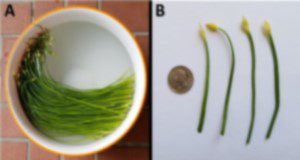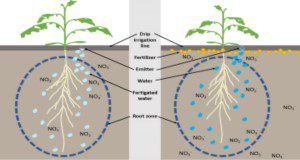Chinese mustard is a nutritious leafy vegetable in the family Brassicaceae. Chinese mustard also goes by many common names, such as brown mustard, mustard greens, leaf mustard, Indian mustard, Oriental mustard, and vegetable mustard. Although it is considered a weed in a few states, such as Michigan, this species is not listed as invasive in Florida and has been cultivated in several counties, including Levy, Palm Beach, and Miami-Dade. This new 8-page publication of the UF/IFAS Horticultural Sciences Department provides a short cultivation guide as well as information on the uses and marketability of Chinese mustard. Written by Yuheng Qiu, Mary Dixon, and Guodong Liu.
https://edis.ifas.ufl.edu/hs1402
Tag: Mary Dixon
Tomato Production in Florida Using Fertigation Technology
Tomato is in high demand because of its taste and health benefits. In Florida, tomato is the number one vegetable crop in terms of both acreage and value. Because of its high value and wide acreage, it is important for tomato production to be efficient in its water and nutrient use, which may be improved through fertigation practices. Therefore, the objective of this new 7-page article is to disseminate research-based methods of tomato production utilizing fertigation to enhance yield and nutrient use efficiency. Written by Mary Dixon and Guodong Liu, and published by the UF/IFAS Horticultural Sciences Department.
https://edis.ifas.ufl.edu/hs1392
Leek Cultivation Guide for Florida
Leek (Allium porrum L.) is a member of Amaryllidaceae, a family with ornamental crops, like amaryllis, and with vegetable crops, like onion. Leek is a highly demanded vegetable because of its flavor and nutrient content. Although there is great potential for leek to be grown commercially in Florida due to demand and appropriate climatic conditions, the United States does not currently produce a significant quantity of leek compared to countries such as Indonesia, Turkey, and China. This new 7-page publication of the UF/IFAS Horticultural Sciences Department, written by Mary Dixon and Guodong Liu, provides a basic guide to cultivation of leek in Florida, as well as information on its agricultural, culinary, and medicinal uses.
https://edis.ifas.ufl.edu/hs1388
Implementing the Five Rs of Nutrient Stewardship for Fertigation in Florida’s Vegetable Production
The five Rs of nutrient stewardship is a mnemonic device used to emphasize accuracy and precision for nutrient management so as to apply the (1) right source of fertilizer at the (2) right rate at the (3) right time in the (4) right place with the (5) right irrigation. Because the majority of Florida’s soils are sandy, this fifth R is imperative for sustainable nutrient management for commercial crop production. These main points of nutrient management (source, rate, time, place, irrigation) may help enhance sustainability by reducing pollution by eutrophication, nitrogen loss through ammonia volatilization, and climate change from soil greenhouse gas emission. This new 8-page publication of the UF/IFAS Horticultural Sciences Department was written by Mary Dixon and Guodong Liu.
https://edis.ifas.ufl.edu/hs1386
Daikon Radish Cultivation Guide for Florida
Daikon radish is a versatile vegetable crop in the mustard family. It produces a large, white, cylindrical fleshy root weighing up to 4-7 lb. Daikon radish is an especially common vegetable in Asia, particularly Japan, and it tends to be less spicy than other garden types of radish. This new 7-page publication of the UF/IFAS Horticultural Sciences Department provides a primer on cultivation of daikon in Florida, including sections on propagation, growing conditions, pests and diseases, and agricultural, culinary, and medicinal uses. Written by Mary Dixon and Guodong Liu.
https://edis.ifas.ufl.edu/hs1370




